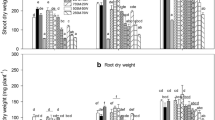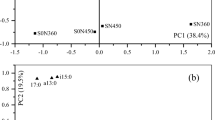Abstract
In a greenhouse pot study, we examined the availability of N to grain sorghum from organic and inorganic N sources. The treatments were15N-labeled clover residues, wheat residues, and fertilizer placed on a sandy clay loam and loamy sand soil surface for an 8-week period. Soil aggregates formed under each soil texture were measured after 8 weeks for each treatment. Significantly greater 15N was taken up and recovered by grain sorghum in sandy clay loam pots compared with loamy sand pots. Greater 15N recovery was consistently observed with the inorganic source than the organic sources regardless of soil texture or time. Microbial biomass C and N were significantly greater for sandy clay loam soil compared with the loamy sand. Microbial biomass 15N was also significantly greater in the sandy clay loam treatment compared to the loamy sand. The fertilizer treatment initially had the greatest pool of microbial biomass 15N but decreased with time. The crop residue treatments generally had less microbial biomass 15N with time. The crop residues and soil texture had a significant effect on the water-stable aggregates formed after 8 weeks of treatments. Significantly greater water-stable aggregates were formed in the sandy clay loam than the loamy sand. Approximately 20% greater water-stable aggregates were formed under the crop residue treatments compared to the fertilizer only treatment. Soil texture seemed to be one of the most important factors affecting the availability of N from organic or inorganic N sources in these soils.
Similar content being viewed by others
References
Aulakh MS, Doran JW, Waters DT, Mosier AR, Francis DD(1991) Crop residue type and placement effects on denitrification and mineralization. Soil Sci Soc Am J 55:1020–1025
Azam F, Malik KA, Sajjad MI, (1985) Transformations in soil and availability to plantsof 15N applied as inorganic fertilizer and legume residues. Plant and Soil 86:3–13
Burns RG, Davies JA (1986) The microbiology of soil structure.Biol Agric Hortic 3:95–113
Cabrera ML, Beare MH (1993) Alkaline persulfate oxidation for determining total nitrogen in microbial biomass extracts. Soil Sci Soc Am 57: 1007–1012
Corak SJ, Frye WW, Smith MS, Grove JH, Mackown CT (1987) Fertilizer nitrogen recovery by no-till corn as influenced by a legume cover crop. In: Power JT (ed) The role of legumes in conservation tillage systems. Soils Cons Soc Am, Ankeny,Iowa, pp 43–44
Fahrney KS, El-Swaify SA, Lo AKF, Joy RJ (1987) Maize yields and soil loss with conservation and conventional tillages on a tropical Aridisol. In: Power JT (ed) The role of legumes in conservation tillage systems. Soil Cons Soc Am, Ankeny, Iowa,pp 138–140
Harper LA, Sharpe RR, Langdale GW, Giddens JE(1987) Nitrogen cycling in a wheat crop: Soil, plant, and aerial nitrogen transport. Agron J 79:965–973
Harris G, Hestermann OB (1990) Quantifying the nitrogen contribution from alfalfa to soil and two succeeding crops using nitrogen-15. Agron J 82:129–134
Hoagland DR, Arnon DI (1950) The water-culture method for growing plants without soil (revised). Calif Agric Exp St Circ 347
Jansson SL, Persson J (1982) Mineralization and immobilization of soil nitrogen. In: Stevenson FJ (ed) Nitrogen in agricultural soils. Am Soc Agron, Madison, Wis, pp 229–252
Jordan D, Beare MH, (1991) A comparison of methods for estimating soil microbial C. AgricEcosyt Environ 34:35–41
Jordan D, Harris D, Rice CW, Tiedje JM (1987) Fate of nitrogen mineralized from nitrogen-15-labeled alfalfa in no-till, intercropped corn. In: Power JT (ed)The role of legumes in conservation tillage systems. Soil Cons Soc Am, Ankeny, Iowa, p60
Jordan D, Rice CW, Tiedje JM (1993) The effect of suppression treatments on the uptake of 15N by intercropped corn from labeled alfalfa (Medicago sativa). Biol Fertil Soils 16:221–226
Keeney DR, Nelson DW (1982) Nitrogen-inorganic forms. In: Page AL, Miller RH, Keeney DR (eds) Methods of soil analysis part 2: Chemical and microbiological properties. Am Soc Agron,Madison, Wis, pp 643–693
Kemper WD, Rosenau RC (1986) Aggregate stability and size distribution. In: Klute A (ed) Methods of soil analyis, part 1: Physical and mineralogical methods. Am Soc Agron, Madison, Wis, pp 425–441
Lachat Chemicals, Inc (1985) Lachat Quikchem Instructions Manual. Lachat Chemicals, Mequon, Wis
Miller DE, Kemper WD (1962) Water stability of soils as influenced by incorporation of alfalfa. Agron J 54:494–496
Nelson DW, Sommers LE (1982) Total carbon, organic carbon and organic matter. In: Page AL, Miller RH, Keeney DR(eds) Methods of soil analysis, part 2: Chemical and microbiologial properties. Am Soc Agron, Madion, Wis, pp 539–577
Preston T, Owens NJP (1983) Interfacing an automatic elemental analyzer with an isotope ratio mass spectrometer:The potential for fully automated total N and nitrogen-15 analysis. Analyst 108:971–977
Rice CW, Smith MS (1984) Short-term immobilization of fertilizer nitrogen at the surface of no-till and plowed soils. Soil Sci Soc AM J 48:295–297
SAS (1988) SAS User Guide, 6.03 edn. SAS Institute, Cary, NC
Smith SJ, Sharpley AN (1990) Soil nitrogen mineralization in the presence of surface incorporated crop residues. Agron J 82:112–116
Sturgul SJ, Daniels TC (1987) Effect of tillage on runoff, erosion, and first-year alfalfa yields. In: Power JT (ed) The role of legumes in conservation tillage systems. Soil Cons Soc Am, Ankeny, Iowa, pp 140–142
Tisdall JM,Cochcroft B, Uren NC (1978) The stability of soil aggregates as affected by organic materials,microbial activity, and physical disruption. Aust J Soil Res 16:9–17
Varco JJ, Frye WW, Smith MS, Grove JH (1987) Legume nitrogen transformation and recovery by corn as influenced by tillage.In: Power JT(ed) The role of legumes in conservation tillage systems. Soil Cons Soc Am, Ankeny, Iowa, p 40
Yaacob O, Blair GJ, (1980) The growth and nitrogen uptake of Rhodesgrass grown on soils with varying histories of legume cropping. Plant and Soil 57:249–255
Author information
Authors and Affiliations
Additional information
Contribution from the MissouriAgricultural Experiment Station, Journal Series No.12131
Rights and permissions
About this article
Cite this article
Jordan, D., Bruce, R.R. & Coleman, D.C. Nitrogen availability to grain sorghum from organic and inorganic sources on sandy and clayey soil surfaces in a greenhouse pot study. Biol Fert Soils 21, 271–276 (1996). https://doi.org/10.1007/BF00334903
Received:
Issue Date:
DOI: https://doi.org/10.1007/BF00334903




